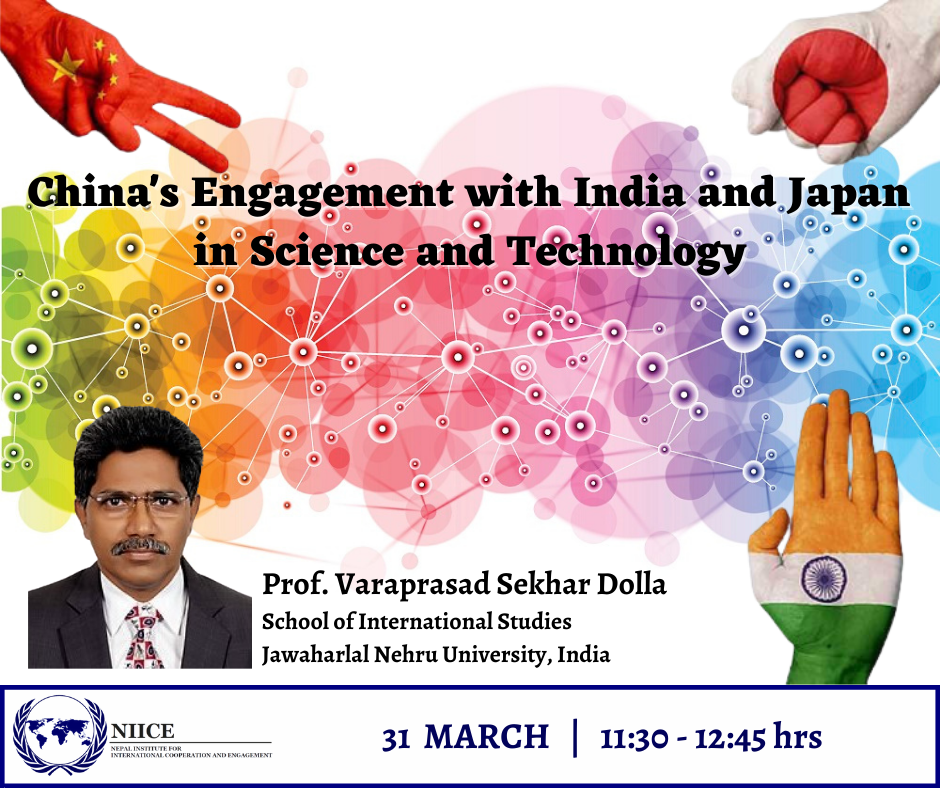
China’s Engagement with India and Japan in Science and Technology
Watch it on NIICE Nepal YouTube Channel
Event Report
The event was organised by NIICE Nepal and invited Professor Varaprasad Shekhar Dolla. Professor Varaprasad Sekhar Dolla is Professor at Center for East Asian Studies, School of International Studies, Jawaharlal Nehru University, New Delhi. He has been teaching in Chinese Studies since more two decades. He teaches two courses on Chinese history and science & technology. He was ASIA (Asian Studies in Asia) Fellow at Peking University, Beijing in 2004. He holds his M.Phil. and PhD from Jawaharlal Nehru University, New Delhi. He has published books titled Science and Technology in Contemporary China: Interrogating Policies and Progress, and Innovation in China and India: A Critique on Dynamics and Dilemmas and contributed several research papers in journals and books besides presenting papers in the international and national conferences.
Prof. Dolla in this seminar talked about his perspectives on China’s engagement with India and Japan in the fields of science and technology. Prof. Dolla states the trajectory of China’s engagement in India and Japan in science has witnessed an interesting change in basic assumptions driven primarily by a sustained and rapid development of science and technology in China in the last few decades except for nuclear technology, but he states that China was on par with India and way behind Japan in science and technology capabilities in the late 1970’s. Now after decades of sustained development in science and technology, China is now ahead of India and Japan in certain fields. China’s engagement with Indian and Japan is riddled with two paradoxical elements of cooperation and competition.
If we look at the development of science and technology, there is a robust causality between science and technology and economic growth. Many economists estimate that the growth in science and technology in a country leads to greater growth in economies. In India and China, there is 30% growth in economies that is the driven by science and technology. With the growth in ICT and in addition to this we have seen growth of AI (Artificial Intelligence) and analytics and robotics etc. in the last three or four decades we have seen a tremendous growth in science and technology. These three countries really understood the centrality of science and technology for their growth but of course with varying degrees for instance Japan was one of the first countries to realize the importance of this and was the first to start importing substantial number of technologies from the west and then China tries to emulate Japanese models in some ways and now India has been in the race for quite some time.
Historically, prior to 19th century, both India and China have the legacy of impressive contribution to global ascent however Japan took the lead in factoring S&T development in the 19th and 20th centuries and Japan became a pioneer in several S&T fields and emerged a model particularly for China. Interestingly, all three countries were recipients of advanced western technologies but now these countries have emerged as suppliers of these advanced technologies to other developing countries. Prof. Dolla also shared a table which shares details about the growing progress in science and technology fields.
Now, discussing relations btw China and India where we see interesting development whereby China has engaged with India in science and technology, we see that in 1950s-1960s there was not much to offer but after the development of S&T capabilities the two countries emerged as exporting giants. Both the countries permeate information technology, biotechnology, agricultural machinery, energy related technology and in this process, we find private initiatives from both the countries. India and China in 1990 and 1988, former Prime Minister Rajiv Gandhi stressed on economic, scientific, and technological and even cultural cooperation between both the countries. In 1991 both the countries signed several MOUs in the realm of agricultural technologies, S&T, chemistry biological sciences and many other fields. India and China also contributed to the development of IT (Information Technology) corridors with both Indian and Chinese enterprises entering each other’s markets.
The trajectory of Japan-China engagement began with asymmetry way back in 1950s and 60s but after 70 years the S&T capabilities in Japan led Japan to grow its economy and Japan supplied several technologies to China when China had a conflict with Soviet Union. Japan in early 1960s supplied China with various technologies worth $300 million and between 1972-1975 Chinese total technologies import were $3.1 billion (about $10 per person in the US) and Japan was a major contributor. Japanese contribution to the Chinese development in science and technology is quite substantial and China also received ODA (Official Development Assistance) from Japan both in 89s and 90s. the 1990s however, changed the course of Japan as being the contributor to the development of China, now China opened its economy with the western companies investing in China. Chinese saw Japanese as an important model but at the same time we see two elements that has characterized S&T engagement between the countries one of which is Techno Nationalism, and the other is Techno Parochialism. The Japanese were also little apprehensive in supplying technologies to China in the context that China will catch up with them also there was certain American pressure of Japan not to supply certain sensitive technologies. Therefore, the S&T engagement between China and Japan is also characterized by two elements which are cooperation and caution.
Concluding the discussion, Prof. Dolla states that the three countries the development of science and technology has been pivotal in the transformation of their developmental architectures and China’s engagement with India and Japan in S&T has witnessed two distinct trajectories as the discussion above indicates in the case of India and China private countries led from front while in the case of Japan and China the government actually played a leading role in the initial phase considering the size of Chinese markets.
Prepared by Vaishnavi Sharma, Intern at NIICE, Nepal

Recent Comments